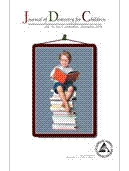
Clinical Performance of Class II Adhesive Restorations in Pulpectomized Primary Molars: 12-month Results
The purpose of this report was to present the 12-month results of a prospective, randomized study evaluating the clinical and radiographic success rates of Class II adhesive restorations in pulpectomized primary molars. A total of 75 restorations were placed over root canal-treated primary molars, filled with a calcium hydroxide paste. The restorative systems tested were: (1) group 1: amalgam (negative control); (2) group 2: a hybrid resin composite (TPH, Dentsply) with prior acid conditioning and bonding with an etch-and-rinse adhesive (Prime&Bond NT, Dentsply); (3) group 3: a polyacid-modified resin composite (Dyract, Dentsply) bonded with Prime&Bond NT; (4) group 4: Dyract with prior nonrinse conditioner (NRC) treatment and bonding with Prime&Bond NT; and (5) group 5: a polyacid-modified resin composite (F2000) in conjunction with a self-etch adhesive (Prompt-L-Pop, 3M/ESPE). The restorations were evaluated clinically using the modified USPHS/Ryge criteria at 1, 2, 3, 4, 5, 6, 9, and 12 months. Radiographic evaluations were made in accordance with predetermined criteria. During the evaluation period, 12 teeth (group1=4, group2=1, group3=4, group4=3, and group5=2) were extracted due to radiographic evidence of failure. There was no difference between groups regarding the clinical evaluation criteria (P>.05) except marginal discoloration at 9 and 12 months (P<.05). The overall success rate at 12 months was 81% (group 1=73%, group 2=93%, group 3=73%, group 4=80%, and group 5=87%). Teeth restored with the resin composite+total-etch/bonding (group 2), followed by those with F2000+self-etch adhesive (group 5) exhibited the highest clinical and radiographic success rates. Radiographic failures observed beneath failed restorations were strongly suggestive of coronal microleakage.
Keywords: COMPOMER; COMPOSITE RESIN; PULPECTOMY; TOOTH PRIMARY
Document Type: Research Article
Affiliations: Department of Pediatric Dentistry, Faculty of Dentistry, Hacettepe University, Ankara, Turkey
Publication date: 01 January 2008
- Acquired after the merger between the American Society of Dentistry for Children and the American Academy of Pediatric Dentistry in 2002, the Journal of Dentistry for Children (JDC) is an internationally renowned journal whose publishing dates back to 1934. Published three times a year, JDC promotes the practice, education and research specifically related to the specialty of pediatric dentistry. It covers a wide range of topics related to the clinical care of children, from clinical techniques of daily importance to the practitioner, to studies on child behavior and growth and development. JDC also provides information on the physical, psychological and emotional conditions of children as they relate to and affect their dental health.
- Information for Authors
- Submit a Paper
- Subscribe to this Title
- Membership Information
- Information for Advertisers
- Ingenta Connect is not responsible for the content or availability of external websites
- Access Key
- Free content
- Partial Free content
- New content
- Open access content
- Partial Open access content
- Subscribed content
- Partial Subscribed content
- Free trial content